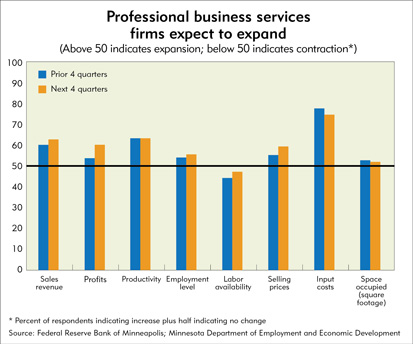Accountants, engineers, graphic designers, market researchers, management consultants and other professional service providers had a decent year based on the annual survey of professional services firms conducted by the Federal Reserve Bank of Minneapolis and the Minnesota Department of Employment and Economic Development.
Over the past four quarters, professional services firms experienced solid growth, with increased sales and productivity (see chart). Slightly more firms reported higher profits than lower profits, as higher selling prices and volumes were partially offset by higher input costs and increased employment. Firms reported that labor availability was reduced, access to bank credit increased slightly and space usage was relatively flat. The outlook for the next four quarters is upbeat, as more respondents expect increases rather than decreases in sales prices and revenue, along with employment, productivity and profits. More employers expect their state’s economy to pick up rather than slow down over the next four quarters.
Many services firms expanded over the past year. Forty-eight percent of firms reported increased sales versus 27 percent reporting decreases. This is consistent with the predictions made in last year’s survey, in which 48 percent expected increased sales revenue and 16 percent expected decreases. This year’s sales revenue increases were partially due to higher selling prices (26 percent said up and 10 percent said down) and additional employment (25 percent added employees and 17 percent reduced employees).
Overall profits increased slightly, with 41 percent of firms seeing higher profits compared with 35 percent reporting lower profits. Besides higher sales revenue, productivity also helped profits, as 37 percent reported more efficient operations, while 11 percent reported decreased productivity. Factors hindering profits included higher input costs, cited by 57 percent of respondents, while just 4 percent reported lower input costs. Compensation also increased: Wages per worker increased 2.4 percent over the past year, and benefits increased by an average of 2.1 percent. Available financing increased slightly over the past three months: 12 percent of respondents reported improved access to bank credit, while 9 percent reported more difficult access.
The services industry should continue to grow over the next year. Sales and profit increases are expected by 47 percent and 41 percent of respondents (respectively), compared with 19 percent and 22 percent (respectively) expecting decreases. More than half of respondents also anticipate higher input costs compared with just 4 percent expecting lower input costs. More firms expect selling prices to increase than decrease (28 percent and 10 percent) and productivity to improve (35 percent) rather than decline (9 percent). Wages and benefits for the coming year are expected to rise about 2 percent. Employment is expected to rise at 24 percent of the firms and drop at 11 percent.
When asked about the Affordable Care Act’s effect on employment mix, 13 percent reported that they already have shifted to more part-time workers, while 10 percent are planning a similar shift during the next two years. But more than three-quarters of respondents expected no shift to more part-time workers.
The firms expect their state economies to expand as well: 45 percent expect increased overall employment, while 12 percent expect to see falling employment in their state. As well, 43 percent of firms expect higher consumer spending. While corporate profits are expected to increase, 56 percent also expect higher inflation, with only 2 percent believing that inflation will decrease.
Ninth District Professional Business Services Survey Methodology — May 2013
Of the approximately 20,000 Ninth District professional business services firms (most firms in NAICS code 541), a stratified random sample of 2,200 businesses was drawn from the population. For each state, the population was stratified based on employment size; the sample includes 100 percent of establishments with more than 49 employees, 30 percent with 5 to 49 employees and 4 percent with fewer than 5 employees.
A postcard survey was mailed to each of the selected businesses. The mailing was sent in late April, and a second mailing was sent in mid-May to businesses that did not respond to the first mailing. A cutoff for survey responses was May 31. A total of 450 usable surveys were received, for a response rate of 21 percent.
Survey results were tabulated for all professional business services firms. The confidence interval for sampling error was calculated. The 95 percent confidence interval for the results is plus or minus 4.6 percentage points. Results are also subject to errors introduced by other factors, such as the wording of questions and differences between survey respondents and nonrespondents.
Note: The Minnesota Department of Employment and Economic Development produced and processed the surveys for Minnesota firms, and the Federal Reserve Bank of Minneapolis conducted the survey for manufacturers in Montana, North and South Dakota, Ninth District counties in western Wisconsin and the Upper Peninsula of Michigan.
Business Poll Results [xls]






